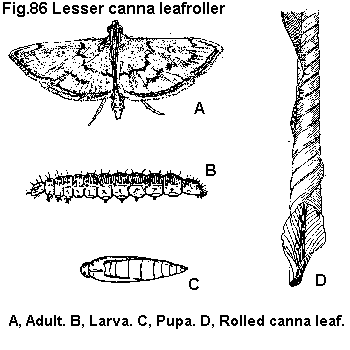 Fig. 86 Lesser canna
leafroller. Geshna cannalis (Quaintance), Pyralidae,
LEPIDOPTERA
Fig. 86 Lesser canna
leafroller. Geshna cannalis (Quaintance), Pyralidae,
LEPIDOPTERA Return to: MREC Home Page Return to: Key to Caterpillars
CATERPILLARS
Lesser Canna Leafroller
DESCRIPTION
Adult - The lesser canna leafroller moth has a wingspan of 25 mm. Adults often rest upside down on a shady portion of the plant with the forewings straight out from the body and the hind wings fanned out so their rear margins form a low arch. The wings are light brown with dark lines that form two irregular, concentric low arches.
Egg - The egg is oval, 0.9 mm long, and flat. It is whitish yellow and occurs with six to 15 others in a mass.
Larva - Lesser canna leafroller caterpillars grow from 1.4 mm to 23 mm long. The head of the young caterpillar is relatively wide, and the body tapers gradually to the tail. Older larvae are more or less cylindrical and taper toward the head and tail. These caterpillars are cream to greenish, and the heads of all stages are yellowish.
Pupa - The pupa is 11.5 mm long. The head, thorax, and wings are chocolate brown, and the abdomen is somewhat lighter.
 Fig. 86 Lesser canna
leafroller. Geshna cannalis (Quaintance), Pyralidae,
LEPIDOPTERA
Fig. 86 Lesser canna
leafroller. Geshna cannalis (Quaintance), Pyralidae,
LEPIDOPTERA
A, Adult. B, Larva. C. Pupa. D, Rolled canna leaf.
BIOLOGY
Distribution - The lesser canna leafroller is found throughout the southeastern United States. Since Canna is native to Central America and tropical South America, it seems likely the lesser canna leafroller also occurs in these regions.
Host Plants - Lesser canna leafrollers apparently feed only on plants in the genus Canna.
Damage - Lesser canna leafroller caterpillars fasten the edges of leaves before the leaves unroll or the caterpillars can roll up one side of an open leaf. Within this shelter, the caterpillars feed on the upper surface of the leaves, rarely chewing through the lower epidermis except when the caterpillar bores through the rolled leaves. Infested leaves become ragged and shot through with holes. Heavily infested leaves may never open and may die. Infested plants become unsightly and fail to bloom.
Life History - The lesser canna leafroller overwinters as medium to large larvae within rolled, dead leaves of the frost-killed tops in central North Carolina. The caterpillars are apparently not cannibalistic as five or six larvae may reside in one rolled leaf. These larvae pupate and adults appear in February and March in Florida and probably March and April in North Carolina. Females lay eggs in small patches of six to 15 which are firmly glued to the plant but without much order (some overlapping and some directly on top of others). Tiny new caterpillars mine into the leaves until they outgrow the tunnels. They then chew a circular hole to the upper surface and begin to roll the leaves. The caterpillars may feed gregariously. Some of the larvae may crawl down inside the petiole and feed there. When fully grown, the caterpillars pull the surface of the leaf firmly together and spin a filmy cocoon. After pupating, adults emerge 10 to 12 days later. In North Carolina, the second generation emerges in June. During the summer, lesser canna leafrollers may be found in any stage.
CONTROL
Because lesser canna leafrollers overwinter as larvae in rolled canna leaves, collecting and destroying the above ground portions of cannas during the winter will remove most of the population. During the growing season, contact insecticides should be directed downward so as to force the residue into the open tops of the rolled leaves. For specific chemical control recommendations, see current Cooperative Extension publications on ornamental plant pest management
Reference to University of Florida/IFAS Pest Control Guides